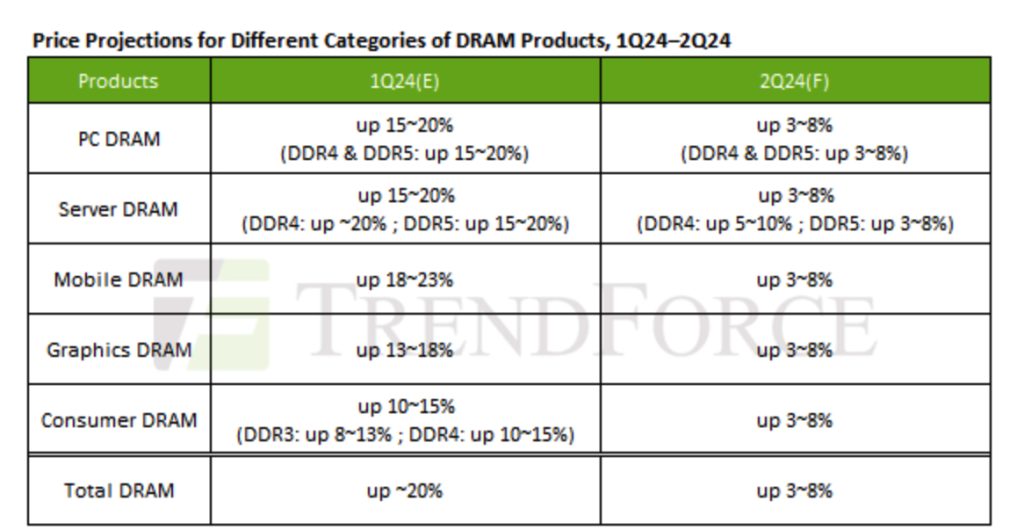2Q24 DRAM Price Increase Expected to Narrow to only 3-8%
Suppliers aim to raise contract prices, but with uncertain demand.
This is a Press Release edited by StorageNewsletter.com on April 3, 2024 at 2:03 pmPublished on March 26, 2024, this market report was written Avril Wu, Mia Huang, Mark Liu and Ellie Wang, analysts at Trendforce Corp.
2Q24 DRAM Price Increase Expected to Narrow to only 3-8%
Suppliers aim to raise contract prices, but with uncertain demand
This report reveals that despite DRAM suppliers’ efforts to trim inventories, they have yet to reach healthy ranges. As they continue to improve their lose situations by boosting capacity utilization rates, the overall demand outlook for this year remains tepid. Additionally, significant price increases by suppliers since 4Q23 are expected to further diminish the momentum for inventory restocking. As a result, DRAM contract prices for 2Q24 are projected to see a modest increase of 3–8%.

The shift toward DDR5-compatible CPUs is set to drive an increase in PC DRAM demand in 2Q24. As manufacturers move toward more advanced, cost-efficient production processes for DDR5, their profitability is expected to rise significantly. This anticipation of higher DRAM prices in 1H24 has led to suppliers to aim for price increases in 2Q24, targeting a 3-8% hike in PC DRAM contract prices. Notably, even though DDR5 prices have already seen a notable rise in 1Q24 – exceeding the average increase for other products – the expected emergence of AI PC demand may lead to a slight moderation in DDR5 price increases in 2Q24.
The server DRAM sector sees ongoing interest in accumulating DDR5 inventory. Yet, as of 1Q24, DDR5 has not penetrated the market as much as anticipated, suggesting its demand has not fully materialized. To address this, manufacturers are boosting DDR5 production and employing volume bundling strategies to enhance profitability, which, in turn, is leading to a gradual weakening in DDR5 price increases. On the other hand, DDR4 is experiencing less pressure to reduce prices due to capacity constraints. Consequently, DDR4 contract prices are expected to rise more than those for DDR5 in 2Q24, gradually closing the price gap between the 2. Overall, server DRAM contract prices are projected to increase by about 3-8% in 2Q24 to reflect these market dynamics.
The mobile DRAM market reflects a balanced buyer inventory but lacks significant demand resurgence, leading to a passive stance in 2Q24 negotiations. A reduction in production, coupled with robust demand that has persisted from 2H23 into 1Q24, has significantly depleted manufacturers’ inventories. This shift has altered bargaining dynamics, moving away from a supply glut that previously disadvantaged suppliers in negotiations. Manufacturers, aiming to boost their profitability, have set an ambitious target for 2Q24 mobile DRAM contract prices to increase by 10-15% or more, indicating a strong negotiating posture. However, the analyst firm believes that the passive negotiating stance of buyers may temper suppliers’ aggressive pricing intentions, estimating a more moderate price increase of 3-8% for mobile DRAM in 2Q24.
In the graphics DRAM sector, the momentum from other DRAM products has helped usher in a period of strong price increases that continues to drive purchasing activity. Demand for mainstream GDDR6 16Gb spec remains high, with buyers generally willing to accept the sellers’ price increases. Currently, there are no signs of prices loosening or declining. Additionally, manufacturers are shifting similar production capacities to the HBM domain, leading to a relatively conservative production plan for GDDR. Given the niche market position of graphics DRAM, the future sales momentum of end products is also critical to watch. To achieve price increases across all DRAM categories, graphics DRAM contract prices are projected to rise by 3-8% in 2Q23.
Consumer DRAM finds stable demand primarily in AI-related sectors and selective inventory restocking in TV and networking. However, the market remains weak due to the slow progress of projects in the Chinese telecom and internet sectors. There’s a notable difference in pricing strategies between major global manufacturers and Taiwanese firms; the former has capitalized on the AI boom, significantly reducing their inventories and adopting a firm stance on price increases in response to loss pressures over the past 2 quarters. In contrast, Taiwanese manufacturers continue to face inventory pressures, leading to a more gradual approach to price increases. Despite an ample supply in the overall market, rising prices have encouraged buyers to stock up early. As a result, the increase in consumer DRAM contract prices for 2Q24 is expected to moderate, settling at an estimated growth of 3-8%.















 Subscribe to our free daily newsletter
Subscribe to our free daily newsletter

